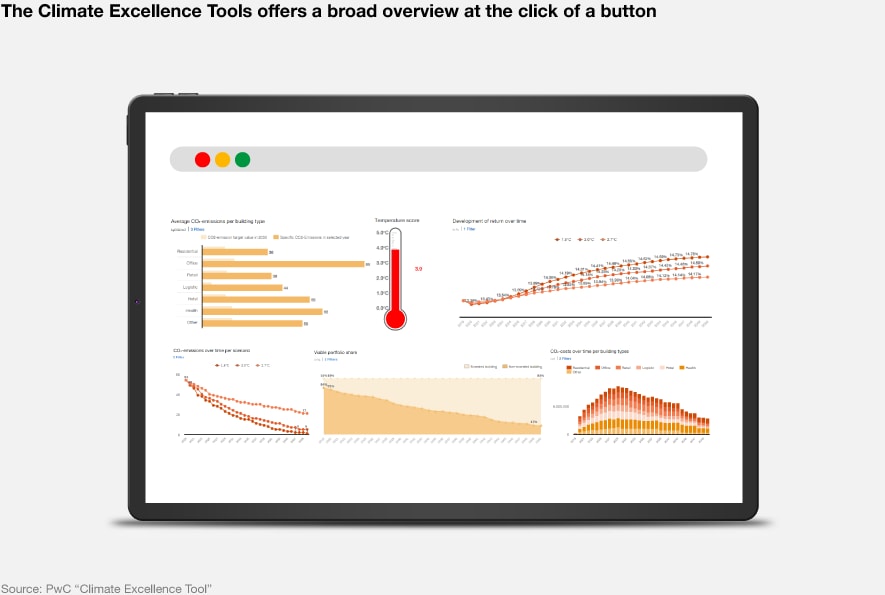
Read in this case study how we helped a German car manufacturer to become more resilient with the help of PwC’s climate scenario analysis.
Your expert for questions

Gunther Dütsch
Partner, Sustainability Services & Climate Risk at PwC Germany
Email
PwC’s “Climate Excellence tool” supports companies from the financial and real economy in conducting climate scenario analyses to make their portfolios fit and future-proof for the risks and opportunities of climate change. This enables them to realize increases in value, adequately manage risks, and set up a long-term sustainability strategy and compliant reporting.

This is a modal window.
According to the Intergovernmental Panel on Climate Change’s Sixth Assessment Report, climate change is becoming more drastic and the critical global warming mark of 1.5°C is likely to be exceeded by 2030. Global warming is leading to increasingly frequent and severe weather extremes.Climate change and climate protection are having an ever greater impact on economic developments. They also entail major financial risks: From power plants that do not come on stream, to the electrification of individual transport, to the increasing energy requirements for buildings.
The pressure to act on the part of politicians is increasing. The EU is supposed to be climate-neutral by 2050. A joint effort that requires a radical turnaround – also for companies, banks and insurances.
Regulators such as the European Central Bank (ECB) or the European Insurance and Occupational Pension Authority (EIOPA) emphasise the importance of this goal, for example in the ECB consultation paper on climate risks and the guideline for non-financial reporting or in the EIOPA application guidance on climate change materiality assessment and climate change scenarios in the own risk and solvency assessment (ORSA). Additionally, more and more reporting requirements like the framework of the Corporate Sustainability Reporting Directive (CSRD) and the EU taxonomy are already shaping the necessity for climate risk analysis and management of financial institutions and the real economy.
Requirements:

In this video series, we give you an overview of current ESG regulations and the key aspects of materiality analysis, as well as the ECB stress test.
The TCFD predicts that climate change could put $43 trillion worth of fixed assets at risk by the end of the century. According to a CDP study, the world’s 215 largest companies put the impact of climate risks on their businesses at nearly US$1 trillion – many of which are likely to come due within the next three years. This is due to dynamic market conditions, physical impacts and increasing regulation. To meet climate and energy targets by 2030, the EU Commission expects an additonal annual investment of up to €260 billion per year. The Sustainable Europe Investment Plan is part of the European Green Deal and aims to support both public and private investment in climate projects of at least €1 billion between 2021 and 2030.
How can companies maintain their "license to operate" and prove themselves in rapidly changing markets? The EU Action Plan, the Network for Greening the Financial System and other stakeholders are increasing the pressure to integrate climate-related risks and opportunities. Society, politicians, suppliers, investors and customers are increasingly demanding more transparency and action.
“Climate change is changing the way we know how to do business. In the future, every company will have to consider the risks and opportunities from these changes in its strategy.”
Many questions arise with regard to climate change and possible impacts:
The PwC Climate Excellence tool helps you answer these questions quickly and reliably. The tool’s scenario analyses give you maximum transparency on your portfolios by analysing and visualising financial impacts of climate change.
Climate change-related opportunities and risks are calculated on the basis of various climate scenarios and energy system models. Transitory risks, such as changing prices, demand, technological advances or regulation, as well as physical risks are taken into account. We analyse seven natural hazards that are particularly relevant for the analysis of physical climate risks: Heat waves, floods, thunderstorms, tropical cyclones, wildfires, droughts and sea-level rise.

Climate Excellence is already equally suitable for both the financial and the real economy. The aim of the tool is to cover all industries and sectors in detail. For this reason, PwC will regularly publish new modules in a rapid release rhythm. You will always find news about the releases on this website and on our social media channels.

Read in this case study how we helped a German car manufacturer to become more resilient with the help of PwC’s climate scenario analysis.

Case study: PwC assisted GEA Group with analysing the impacts of climate change and integrating them into the company’s risk and opportunity management programmes

Climate change has the potential to impact the company’s business across the value chain, looking at the example of a global agrochemical company.

A major global bank identified material climate-related risks and their financial impact by using the PwC Climate Excellence tool.
“Using the Climate Excellence tool has enabled Solvay S.A. to quantify climate-related transition and physical risks and opportunities of our business and to test our strategy for resilience against these risks. The PwC-Team facilitated the tailored approach that took specifics of our business model into account. The results made it possible to communicate this topic effectively internally and externally.”
Michel Washer,Solvay S.A.
PwC can help you to analyse and manage climate-related risks and opportunities in line with external regulations such as the CSRD and frameworks such as the TCFD.

Net zero together: we will guide you on your decarbonisation journey with our holistic approach

The PwC climate excellence tool analyzes the impact of climate change on your real estate portfolio.

Dealing with climate change risks - PwC supports pilot project in the insurance industry. Find out more about their approach.
“In the future, every company will have to consider the risks and opportunities of climate change in its strategy. Risk identification and assessment is the first important step.”
Gunther Dütsch,Partner, Sustainability Services at PwC Germany
Gunther Dütsch
Partner, Sustainability Services & Climate Change, PwC Germany
Tel: +49 160 3739019